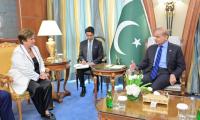The entire focus right now, and self-serving comparisons and polemical reviews, is on fiscal and balance of payments issues as people do not matter in high-profile deliberations over plugging the two deficits that continue to prop up, despite the completion of over a dozen successive IMF structural adjustment programmes.
The likely outcome of the current deliberations between the IMF delegation and their Pakistani interlocutors is going to further suppress demand and development expenditure, bring down GDP growth, increase inflation and interest rates and in the end is not likely to result in fiscal and balance of payments stabilisation on a sustainable basis.
Relying on research regarding IMF programmes by leading economists of the world, such as Barro and Lee, William Easterly (2005), Kentikelenis, Stubbs and King (2016) and others, economist Dr Akmal Husain in his article published in these pages (‘IMF program instead of development?’) on has argued: “such programmmes have consistently failed even in achieving their claimed objectives of growth combined with reduced inflation through financial ‘stabilisation’. Worse, the evidence shows that the IMF programmes have a negative effect on human development”. Ironically, former finance minister Miftah Ismail, who had followed typical IMF recipes, has ridiculed his successor for having taken the same “structural adjustment” route after getting similar financial handouts from the Saudis and the Chinese. The Economist Intelligence Unit report forecasts around three percent GDP growth, up to 14 percent interest rates and double-digit inflation amid a persisting balance of payments crisis. However, with a new programme of the IMF, the sacrificial goat will be Prime Minister Imran Khan’s philanthropic notions about a Madina state or a Scandinavian welfare system based on higher taxation of the rich, and social security.
Parallel to the Pak-IMF track, there are multiple well-researched reports from the UNDP, World Bank and other independent sources that call for urgent attention to alleviate the suffering of an overwhelming majority of the people due to multiple poverty. Lagging behind all South Asian countries, except Afghanistan, Pakistan will again be missing most of the Sustainable Development Goals in terms of the HDI index by 2030. The UNDP’s 2018 statistical update for human development indicators – health, education, income and gender – shows that out of 189 countries, 59 are higher than Pakistan.
Pakistan’s HDI only marginally increased from 0.560 in 2016 to 0.562 in 2017, the lowest in South Asian. The difference between Pakistan, India and Bangladesh is 0.078 and 0.046, respectively. The HDI value for South Asia stands at 0.638 which is 0.076 higher than Pakistan’s HDI value of 0.562. Bangladesh, which lagged behind Pakistan in 1990 in terms of poverty and social indicators, has now overtaken Pakistan by 14 places at 136 – compared to Pakistan which stands at 150th position out of 189 countries. India has moved 20 places ahead at 130th. Nepal has also overtaken Pakistan by jumping to the 149th position. However, on per capita income with $5,311, Pakistan is slightly behind India, even though both represent the largest chunk of the poor in the world.
Judged on the criteria of human development in terms of education, health, and gender, Pakistan is worse off as compared to not very well off South Asians, except Sri Lanka. And the expected years of schooling are 8.6 years in Pakistan as compared to India’s 12.3 years, Nepal’s 12.2 years and 11.4 years in Bangladesh. In Pakistan’s health sector, average life expectancy was 66.6 years in 2017 as compared to Nepal’s 70.6 years, India’s 68.8 years and Bangladesh’s 72.8 years. Women, in terms of the gender inequality index on all three parameters, lag behind men by 0.541 with the lowest participation in the labour force at 24.9 percent as compared to men’s 82.7 percent that places Pakistan on the 133rd place in world ranking. Besides other politico-economic factors, this difference is due to varying priorities and allocation of resources. For example, Nepal spends 3.2 percent on education as compared to Pakistan’s 2.2 percent of GDP.
There is a huge youth bulge in Pakistan, with 64 percent of the population below the age of 30. The Pakistani population grows at the annual rate of 2.4 percent as compared to Bangladesh’s and Nepal’s 1.1 and India’s 1.2 percent. According to the UNDP’s National Human Development Report, with a focus on youth, written by Adil Najam and Faisal Bari, at the current rate of enrolment in schools every child could go to school by 2076. They estimate that the current rate of enrollment would have to be quadrupled if every child were to go to school by the year 2030. For that to happen, Pakistan would have to raise its expenditure on education from 2.2 percent of GDP to 6 percent. This doesn’t include appropriate quality of education for all.
The authors of the report have proposed a ‘Three E’s’ recipe – quality education, gainful employment and meaningful engagement – to not let the youth boom burst into a horrifying bust. Health will also require tripling of current expenditure on primary and specialised healthcare, especially of children and women. In a new World Bank report on ‘The state of water supply, sanitation and its impact on child stunting’, “critical markers of child health– rates of diarrhea and stunting – still do not show any real improvement”. In a food-surplus country, food insecurity continues to add to hunger, impoverishment and malnutrition.
It may be noted that all aggregations of per capita income and GDP growth are misleading. Similarly, the scale of poverty and an overall lack of gainful employment, education and health, shelter, clean drinking water, sanitation and livelihood are unevenly spread across and within the districts. Pakistan’s social and haphazard developmental landscape is now sharply divided between posh societies/towns with lifestyles comparable to the advanced countries and where a few privileged live in luxury as a kind of entitlement as opposed to the vast swaths of masses who living in ghettos, slums and far-flung villages in absolute deprivations.
The recent National Human Development Report on Pakistan loudly speaks about the entitlement of the few and the deprivations of the many, spread unevenly across the provinces. It divides various districts of the provinces into varying categories on the basis of six indicators – instead of four at the global level. Among the highest HDI category are urban districts such as Lahore, Islamabad, Rawalpindi, Karachi, Sialkot, Jhelum and Hyderabad. Quetta, Peshawar, Multan and Faisalabad are in high-medium category. Among ten districts showing least human development, six are in Sindh (Tharparkar, Shikarpur, Mirpur Khas, Ghotki, Badin, Sukkur) four in Balochistan (Quetta, Kill Abdullah, Ziarat, Jhal Magsi). Fifteen districts that remain on very low human development are Balochistan, Tor Ghar and Kohistan in Khyber Pakhtunkhwa and Tharparkar in Sindh. On six HDI criteria, from 2005 to 2015, Punjab improved its HDI from 0.583 to 0.732, Sindh from 0.559 to 0.620, KP from 0.463 to 0.628 and Balochistan from 0.294 to 0.421.
However, the analytical basis and policy framework as proposed by Dr Akmal Hussain and others is worth consideration. But that would have to be preceded by real social and political change in a parasitic power-structure.
The writer is a senior journalist. Email: imtiaz.safma@gmail.com
Twitter: @ImtiazAlamSAFMA
In this picture taken on April 16, 2023, people throng a market area during shopping in Lahore. — AFPCare to cast...
A representational image of a transmission tower, also known as an electricity pylon. — AFP/FileLower electricity...
Pakistan's third Governor General Ghulam Muhammad. — National Portrait Gallery website/FileAs discussed in the...
This image shows Karachi Police personnel and commandos standing guard on November 29, 2023. — Facebook/Karachi...
Earth Day protests carry a vital message that is relevant 365 days a year. — AFP File Earth Day is celebrated every...
People walk along a market in Lahore on May 17, 2023. — AFP/FileMany of us had hoped that the general election...







